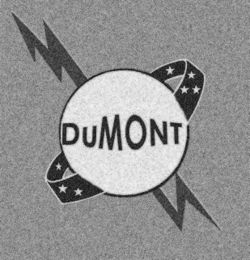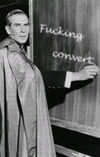DuMont Television Network
“I actually wrote an episode of Captain Video. It's the one where he and the Video Ranger take laudanum.”
“My favorite network!”
| The DuMont Television Network | |
|---|---|

| |
| Type | Broadcast television network |
| Country | |
| Availability | The Twilight Zone |
| Slogan | Crackerjack! (also, Keen!) |
| Founders | Well-intentioned people with no concept of business structure |
| Launch date | After the invention of vacuum tubes, but before the invention of tailfins |
The DuMont Television Network is a now largely-forgotten American broadcast television network that fought against budget troubles for its entire lifetime. It managed to limp along for almost a decade, but dropped off the air at midnight one summer in the 1950s because it didn't have enough money to pay the electric bill, and the squirrels running inside the cage powering the transmitter were getting tired. An attempted comeback on the 2007 MTV Video Music Awards was largely considered a failure.
Although the network vanished from the airwaves, it lives on at YouTube and at UnNews, whose famous newsmagazine Stop Squirming and Hold Still began as a DuMont program in 1952.
History
The DuMont Television Network was launched by DuMont Laboratories when it became apparent that their previous venture, a Death Ray intended for the subjugation of all mankind, was taking too long. They then settled on the next best thing: television.
It went on the air for the first time one dark and stormy night in the late 1940s, where laboratory founder Zanthar du Mont stood before his first operational television camera and proclaimed to the viewing public that they would soon be cowing under the lash of his whip, with more dire boding right after this word from Ovaltine. The DuMont Television Network had been born.
Since there were only a thousand television sets in the world at that time, and only three of them were within range of the broadcasting tower at the DuMont laboratories in New Jersey, the people who actually saw the transmission were unable to convince their neighbors of the horrible danger they were in. Others were laughing too hard.
Therefore, global enslavement never took place. Zanthar du Mont died shortly thereafter when he fell into a robotic thresher prototype and was killed. The entire DuMont fortune was then passed to his nephew and lab assistant, the kind-spirited Aldous du Mont, who pledged to run the company with an even hand and the best interests of the viewers in mind at all times. This being entirely contrary to American business practices, the DuMont Television Network went belly up slightly less than a decade later, with many industry analysts expressing surprise that it took that long. In 1957, the company was bought by Daffy Duck as a tax dodge. Later in 1984, it was replaced by the Q.
Programming
The perpetually impoverished DuMont Network was forced to make many concessions on behalf of its severely limited budget. The company's flagship news program, DuMont BuDget News, was hosted by Howard and Bill (who were actually two sock puppets being operated by a former bus driver) and a parakeet, "Barry the BuDget Budgie," who occasionally squawked the temperature. Weather conditions were broadcast by pointing the camera out the window, which ruined more than one piece of equipment on rainy days. Captain Video was sponsored by the company that provided the string holding up the space ship, also used for cable transmissions (see below). Living Laundry consisted of a camera mounted inside a washing machine, which tended to agitate viewers.
Notable Programs
- Captain Video and His Video Rangers - Conceived under the working title Space on Forty Dollars an Episode, this was the DuMont Network's most famous and longest running show, which pitted the heroic Captain Video against the most fiendish actors looking for work. It ran six days a week for eight years, ending abruptly when the actor who played Captain Video broke free of his leg shackles, knocked the security guard unconscious, and fled into the night.
- Life is Worth Living - Bishop Fulton Sheen made his debut on DuMont when, dressed in his usual ecclesiastical garb, he was mistaken for one of the guest villains on Captain Video, and was pushed onstage. Unprepared to make a villainous speech, he instead handed down moral guidance to the other villains on that week's episode, which proved so popular with viewers that he was soon given his own show. In subsequent weeks, Sheen was issued the costumes the Captain Video villains thought were too ludicrous. He eventually was lured away to ABC by a Bible on a string, which was laid on the ground, and pulled forward a few inches whenever he bent to pick it up.
- The Zenith Radio Hour - Popular with older viewers, The Zenith Radio Hour featured an hour-long close-up of a Zenith brand radio, which was turned on, and then tuned by an unidentified hand (believed to have later played the role of "Thing" on The Addams Family). Occasionally, the hand would adjust the volume on the radio. The hand eventually turned the radio off at the end of an hour of music, entertainment, occasional static and - every once in a while - the sound of someone eating potato chips in the background. This was one of DuMont's most popular programs. As the television critic for the New York World-Telegram wrote at the time, "Clearly, DuMont has reached its Zenith."
- Stop Squirming and Hold Still - Initially appeared during a scheduled broadcast of Captain Video, when the Captain accidentally tried to walk down a flight of prop stairs while on live television. When he fell through and broke his leg, he ended up being treated while the camera continued to roll because nobody was sure it would start again if it was turned off. "Stop squirming and hold still," the orders of the doctor - who was also playing the Evil Lord Golgafrizz in that episode - later went on to become the name of the show when nobody could think of anything better.
- What Would You Do, hosted by Dr. Evelyn Spackett, was a daily fifteen minute self-help program for housebound homemakers who had immigrated from Serbia. Dr. Spackett, who held a doctoral degree in Comparative Serbian Literature, would read mail submitted by viewers that ran the gamut from desert fork placement to wife-swapping. Spackett would ask viewers to mail in their advice on what they would do if faced with the same life problems, and then read those answers on air as well, sometimes in Serbian. Periodically, a guest host, called in whenever Dr. Spackett was out with a Comparative Serbian Literature emergency, would do the exact same thing, only in Swedish. On the final program, Dr. Spackett was replaced with Buddy Hackett before they decided to sack it.
Other Programs
- Big Time Championship Chimp Wrestling
- Cavalcade of the Jamboree of All-Star Sports Bands (now starring John McCain)
- Chad Splink, Space Temp
- Darn Those Socks
- Detective Bukkake of the 187th Precinct
- Don't Torch That Dial
- DuMont BuDget News
- Fashions on Parade
- Fried Egg Theater
- Guess That Smell
- How to Butter Your Bread
- I Don't Want to Hear About It
- Is This Thing On?
- Kaiser-Frazer Adventures in Futility
- Kelvinator Kitchen Quarter Hour
- Kinescope Korner
- The Kraft Melting Cheese Hour
- Late, Late, Early Late Show with Old What's His Name
- Living Laundry
- Music to Splice Film By
- Parade of Fashions
- The Public Domain Cartoon Cavalcade
- The Sherwin-Williams Watching Paint Dry Hour (re-titled Listening To Uncle Jake's Beard Grow in non-network reruns)
- Somebody Change the Channel
- Spend Time with a Mime
- Studebaker Studies the Static
- Subliminal Desperation
- Television Torpor
- Test Pattern and Sermonette
- The Story of Self-Rising Yeast
- Voice of the Longines Firestone Symphonette Hour
- Wait! It Gets Better!
- Watching the Pot Boil
- What's That Clanging?
- You and Your Blender
- Your Hudson Dealer Presents: Rock, Paper, Scissors
Network distribution

The DuMont Network had numerous affiliates all over the country, although the precise number will never be known because most of them are too embarrassed to admit it.
Additionally, the DuMont Network pioneered the idea of cable television, and at first transmitted its signals through a piece of string that was attached to a network-operated can at one end and viewers' TV sets at the other. When this failed to deliver an acceptable picture, the string was upgraded to chicken wire. Near the end of the network's run, a DuMont engineer invented the Electronican, which used electrified lines. Many viewers were shocked. Eventually, a man stood outside the DuMont studios with a megaphone, and loudly repeated the dialogue of various programs to passersby.
Surviving programs
All of the DuMont programs were left in cardboard boxes marked "FREE" on the sidewalk outside the flagship station following the network's demise. The fate of most of these programs is unknown, and many of the recordings that later resurfaced had been taped over. The known surviving DuMont programs are currently in the garage of Dwight Zinn, Jr., of Saginaw, Michigan, where they are presently stored under a bunch of burlap sacks and the hood from an AMC Gremlin, where they will stay until he finally gets around to having that yard sale he's been promising his wife since 1998.



